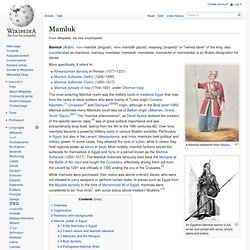

The Mamluks. James Waterson introduces the slave warriors of medieval Islam who overthrew their masters, defeated the Mongols and the Crusaders and established a dynasty that lasted three hundred years.

The battle of Wadi al-Khazandar, 1299. depicting Mamluk cavalry and Mongol archers (14th-century illustration from a manuscript of the History of the Tatars)The Mamluks ruled Egypt and Syria from 1250 until 1517, when their dynasty was extinguished by the Ottomans. But Mamluks had first appeared in the Abbasid caliphate in the ninth century and even after their overthrow by the Ottomans they continued to form an important part of Egyptian Islamic society and existed as an influential group until the nineteenth century.
They destroyed the Crusader kingdoms of Outremer, and saved Syria, Egypt and the holy places of Islam from the Mongols. The dynasty had two phases. From 1250 to 1381 the Bahri clique produced the Mamluk Sultans; from 1382 until 1517 the Burgi Mamluks were dominant. Mamluk. Mamluk (Arabic: مملوك mamlūk (singular), مماليك mamālīk (plural), meaning "property" or "owned slave" of the king; also transliterated as mamlouk, mamluq, mamluke, mameluk, mameluke, mamaluke or marmeluke) is an Arabic designation for slaves.

An Egyptian Mamluk warrior in full armor and armed with lance, shield, sabre and pistols. More specifically, it refers to: While mamluks were purchased, their status was above ordinary slaves, who were not allowed to carry weapons or perform certain tasks. In places such as Egypt from the Ayyubid dynasty to the time of Muhammad Ali of Egypt, mamluks were considered to be “true lords", with social status above freeborn Muslims.[10] The Mamluks under the Ottomans (1517-1798). Encyclopedia Britannica.